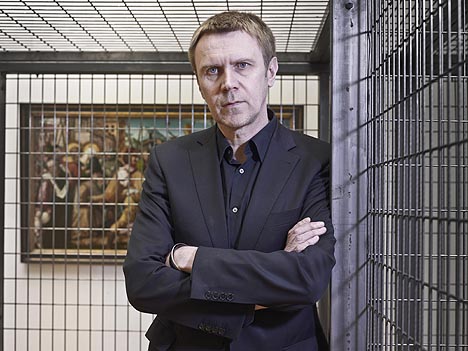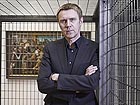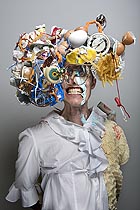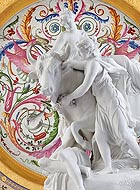
translated and summarized by: Liz Wollner-Grandville,
English summaries July 15 - August 6
Staatliche Kunsthalle Karlsruhe
Miroslaw Balka – We can see you
16.04.2010 – 22.08.2010
Screened views
What is to be done if the special exhibition area is almost non-existent or very limited, yet both the collection as well as the ambition to present it is huge? Pia Müller-Tamm, the new director of the Kunsthalle Karlsruhe came up with a new concept - and it looks like Müller-Tamm’s deliberations gave the museum’s treasures a new perspective - even in the eyes of its loyal core audience.
Currently, everyone who wishes to view the Museum’s substantial collection of Early German art will be led through a corridor formed by wire grating. The corridor stretches over 100 meters and is not narrow enough to make one feel confined but not wide enough to offer ample freedom of movement. It defines the path and prevents any propinquity to the exhibited works.
With his work “How it is”, Miroslaw Balka recently demonstrated what it feels like to enter a pitch-black container over a ramp at London’s Tate Modern. Karlsruhe’s guest curator Julian Heynen’ choice fell upon Balka as the artist most capable of designing a project dealing with the Karlsruhe Kunsthalle's vast collection.
Müller-Tamm described Balka’s work as a “metaphor for a new way of looking at things, which could transpose the museum into a mode of productive unrest.” The Kunsthalle has always offered first class work in the areas of collecting, preserving, researching and mediating - future exhibitions now promise to be exciting.
By Daniela Gregori
In July, Miroslaw Balka was elected to join the Academy of Arts. This international body, which is headquartered in Berlin, advises the German government on cultural issues. New members are elected by secret ballot. Among the main requirements for the election is that the artists significantly “shape the art of their time”.
Staatliche Kunsthalle Karlsruhe
76133 Kunsthalle Hans-Thoma-Strasse 2-6
www.kunsthalle-karlsruhe.de
Opening hours: Tue – Fri: 10 a.m. – 5 p.m., Sat, Sun, Holidays: 10 a.m. – 6 p.m.
Galerie Seywald
Irma Rafaela’s Toledo 100th Anniversary
30.06.2010 - 11.09.2010
Toledo – an artist from Salzburg
After the war was over and one no longer feared reprisals, bombs or destruction, a powerful artist scene emerged. The Art-Club and Otto Mauer are renowned for this new beginning. On its path to Modernism the art scene changed fundamentally and it came as no surprise that not only male but also female artists were part of the new movement. With Agnes Muthspiel (who was also a member of the Art-Club), Trude Engelsberger and Irma Rafaela Toledo, female artists were also a vital part of the “Salzburg Group” founded in 1952. They were oftentimes labelled as “naïve” painters – something that was not the case then and is definitely not the case 60 years later.
On the occasion of her 100th birthday, the Gallery Seywald in Salzburg is currently presenting an exhibition of Toledo’s works. Toledo, being Jewish, hid from the Nazis and survived. When the fatal threat was finally over in 1945, she was not only physically liberated, but also artistically. Her strong desire to paint literally burst forth: “she took a paintbrush in her hand and painted” (Barbara Wally’s “Artists in Salzburg”) and Toledo stuck to what her artist friend Kurt Moldovan once said: “You know that you must become a painter, but you must work every single day.” And she never stopped to paint until her death in 2002.
Other painters did the same: one day they started to paint and continued to do so for the rest of their life. Agnes Muthspiel (1914 – 1966) quickly realized that she had more talent to paint than to write and was inspired by the dominating atmosphere in Salzburg after 1945, characterized among others by Bauhaus artist Max Pfeiffer-Watenphul, former “degenerate” artist Slavi Soucek and stage designer Caspar Neher. Trude Engelsberger (1920 – 1986) also entered the path to painting, and while Agnes Muthspiel was an extroverted artist who loved to travel and enjoyed the company of others, Trude Engelsberger was an introvert and enjoyed being on her own. And while the one painted directly onto canvas or cardboard without sketching, the other needed many little sketches before she began the tedious process of painting, characterized by many overpaintings and ideas until her final oeuvre emerged.
All three of them were not naiiv, a description often used in a derogatory way and oftentimes in reference to women. Not only had these artists learned a lot from others, but also from themselves and they matured through their work. Toledo’s current exhibition clearly proves this. Works spanning over many decades are presented in Salzburg. Her top class style is documented in oil paintings, depicting landscapes, cities, still lifes and portraits. Her techniques included classic oil paintings as well as swift aquarelles, capturing moments or moods. Poetic and sometimes melancholy portraits display her talent in approaching people, and her landscapes are proof of her ability to concentrate on the essential. More and more she turned away from the object and in her cycle on genesis, based on a translation by Martin Buber, abstraction becomes perfection - presented in the “Toledo Room” at the Bildungshaus Schloss Puchberg.
By Angelica Bäumer
In addition to Toledo, the Gallery Seywald also represents Agnes Muthspiel and Trude Engelsberger
Galerie Seywald
5020 Salzburg, Sigmund Haffnerg. 7, 1st Floor
www.galerie-seywald.at/
Opening hours: Tue – Fri: 2.30 p.m. – 6.30 p.m., Sat: 10 a.m. – 1 p.m.
Temporäre Kunsthalle Berlin
John Bock – FischGrätenMelkStand
02.07.2010 – 31.08.2010
Apotheosis or apocalypse?
It is almost a grandiose good-bye party, as if those responsible for the Temporäre Kunsthalle (Temporary Art Hall) wanted to underline what was coming to an end here, in Berlin. John Bock is the Master of Ceremony and he knows what he owes himself and his audience. He curated this exhibition, which attempted to be everything at once: funfair, circus, museum, gallery and cinema.
The floor of the Kunsthalle was actually torn open for this project to allow deeper levels to be found in deeper levels. In a way, this is also valid for the exhibition. It is advisable to enter the exhibit with the map distributed at the entrance. Visitors can easily lose their orientation. The room structures are jumbled and the media present themselves in an unspecific way. Suddenly Edgar Varèse turns up with sound samples, as does a tribute to actor Raimund Harmstorf as “Sea-Wolf” in the same-named screen adaption. Jane Russel’s cigarette stub is a “must”, just like circulation tank #2 from the Research Institute for Water Engineering and Shipbuilding (VWS), Berlin (1968 – 1975) by Ludwig Leo.
This exhibition project leaves customary views behind and draws one’s attention to new horizons. Wasn’t there a short note by Einstein somewhere? And just in time there is an opportunity to view John Hejduk’s model apartment building with its studio tower presented at the International Architecture Show 1987. But this can no longer happen to the Temporäre Kunsthalle because its time has expired - and some people are not shedding a tear. After all, Udo Kittelmann invited “younger” artists such as Tomas Demand to the New National Gallery. But the logic behind this is not very convincing: if the traditional institutions take on the role of the Kunsthalle, a similar additional institution would be superfluous. Yet only an additional new institution offers the competition desirable and necessary for the city of Berlin.
By Thomas Wulffen
Temporäre Kunsthalle Berlin
Berlin, Schlossplatz
www.kunsthalle-berlin.com
Liechtenstein Museum
Showpieces: Neoclassical Porcelain from the Marton Museum in Zagreb
18. 06. 2010 – 09.11.2010
To know one’s own mind
Tennis and Porcelain, according to Veljko Marton, have something in common: “win, lose, and focus” (what he means is “to know one’s own mind”)
The former Croatian professional tennis champion and now entrepreneur started to collect art during his university days – at first silver, glass and porcelain, later he focussed on furniture and paintings. His collections are characterized by their relationship to Croatia, where his collection is located. In 2003, he transformed a 19th century manor in Samobor near Zagreb, where he lived with his family, into Croatia’s first private museum. This step seemed logical after an exhibition presenting part of his collection at the Museum for Art and Crafts in Zagreb was met with great enthusiasm.
The tall and slender 60-year old talks about his accomplishments in an unobtrusive way and in perfect German. Among his accomplishments is a publication on Austrian porcelain in French, which he compiled simply because he “considered this to be an important project”. In Vienna, he was offered porcelain from Sèvres for a favourable price and in Paris he acquired Viennese porcelain, also for an advantageous price due to the fact that the sellers did not have much knowledge on porcelain. In the meantime, prices for Russian porcelain, of which he owns a large collection, have increased significantly.
On a regular basis, Vienna’s Liechtenstein Museum presents private porcelain collections in the rooms of its remarkable libraries: this spring, Cohen, Strasser. and Schober (Schloss Weyer) were invited on the occasion of Meissen’s 300th anniversary. And now the museum is presenting Marton’s porcelain and its propinquity to classicistic Vienna (Sorgenthal era) and sets the “white gold” in a dialog with other objects such as silver sugar bowls and small pieces of furniture – something that dismayed Marton at first. Roughly 20 percent of Marton’s “Showpieces” are displayed in glass cases. The quality of the porcelain seamlessly matches that of the previous exhibitions of private collections.
By Maria-Gabriela Martinkowic
Liechtenstein Museum
1090 Vienna, Fürstengasse 1
www.lichtensteinmuseum.at
Opening hours: Daily, except Tuesday from 9 am
Mehr Texte von translated and summarized by: Liz Wollner-Grandville


 Teilen
Teilen





